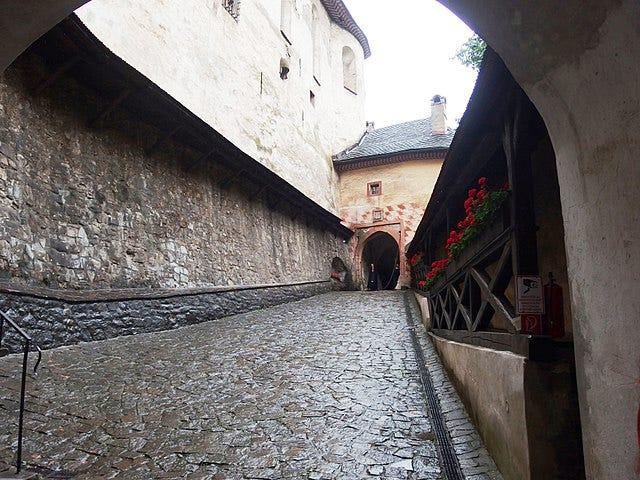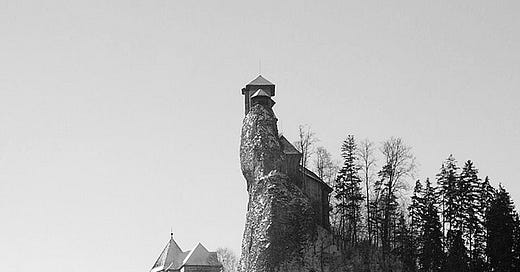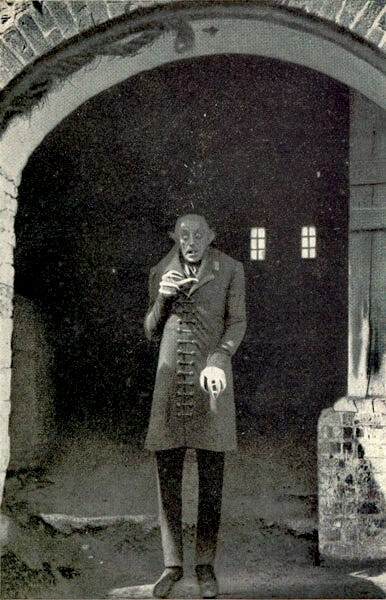I was introduced to the cult classic Nosferatu (1922) in spring break of 2022. Up until that time, I had never heard of it before, but happened upon it by chance while reading up on German expressionism. I still remember it vividly. School work that semester was quite the challenge (Latin poetry will do that to you), thus I planned the whole week out to recuperate while doing absolutely nothing but watch classic movies. I’ve never been so lazy in my entire life! In one week I became a “master” of German expressionist films, devouring a slew of them: Metropolis (1927), The Cabinet of Dr. Caligari (1920), Hitchcock’s third film The Lodger (1927) among others. However, one film in particular stood out among the rest, F. W. Murnau’s Nosferatu. In fact, it impressed me so much I watched it again the following day. Here was a film so odd, strange, horrific, moody, gothic, and utterly charming with its outdated special effects and century old filmmaking. I was in love. What is more, the fact I was watching it on its centennial made it all the more memorable and spooky. It was like discovering an old song and wondering how the hell you had never heard it before.
It was at this time I learned director Robert Eggers - The Witch (2015) - was in the process of making a remake. What is more, Eggers was a diehard fan of the original, which should be a requisite for anyone remaking a franchise or movie in Hollywood. I generally loathe remakes, but Eggers was a talented director, and I was intrigued to see what he might bring to the project. Thus, I went about my merry way, but checked in from time to time for a new trailer or something to spike my interest, and that was that.
Nevertheless, going to watch Nosferatu last week, I went in with modest expectations. The reasons for this were twofold: (1) The Phantom Menace scarred me back in 1999, and like Jake Lloyd, I have yet to regain my childhood innocence, (2) after initially watching the trailer, I had a some worries about some aspects of the film that proved to be correct.
The Good
All the actors were exceptional and played their respective roles sufficiently. By far the standout performance goes to Lily-Rose Depp (Johnny Depp’s daughter) who was unknown to me before this time. Her character goes through hell and back emotionally and what she delivered on screen with her emotions and physicality was impressive. It was draining watching her play particular scenes, so I can’t imagine having to perform them. It will be interesting to see where her career takes her from here.
William Dafoe plays the “crazy” professor whose knowledge of alchemy and the occult prove to be useful in the end. Dafoe’s role (although small) is a key character in the film and his performance was workmanlike. By this point in his long career, this kind of role for Defoe is nothing out of the ordinary, but it’s always a pleasure watching him.
Another standout performance was British actor Ralph Ineson as the doctor. Ineson played a role in Egger’s The Witch, but besides that was unknown to me. His pleasant Yorkshire accent lent a distinguished mood to his character and the film as a whole. His role as the doctor plays a significant part in the film’s contrast between the “progress” of modern medicine and the “pre-Enlightenment” occultic knowledge of Defoe’s professor.
Egger’s direction was commendable and it goes without saying the production design and art direction were superb. Many shots in this film are gothic perfection, and the lighting in particular by Jarin Blaschke was phenomenal. Some scenes in Orlok’s castle were darkness incarnate, with candlelight seeming to be the only light source. It was truly a feast for the eyes.
The Bad
Unfortunately, no matter how bad I wanted to like this movie I just couldn’t. Over and over again throughout its running time I told myself it would get better, and that I needed to be patient with it. However, no matter how hard I tried, it just didn’t move me in the end. After reflecting on this for a week, I’ve determined there were three problems in particular that kept me from enjoying it.
Problem One: Story
Although Egger’s Nosferatu follows more or the less the same plotline from the original, he added many more scenes and fleshed out the characters, which added considerably more running time to the film. The first one’s running time was 1 hour and 21 minutes, while Egger’s runs at 2 hours and 12 minutes. This is quite a difference and it was one of the film’s biggest drawbacks. My biggest gripe with the extra time was that I was utterly board and restless throughout. I constantly checked my watch to see how much longer it was going to be, and I had to remind myself to keep watching and “push” through. Going to a movie shouldn’t feel like a workout.
Of course, I admit the original Nosferatu was a silent film, and thus, not exactly conducive for a long running time. The characters were simple as was the story, but it was how the plot moved forward that made it interesting. Aristotle says this in the Poetics:
All human happiness or misery takes the form of action; the end for which we live is a certain kind of activity, not a quality. Character gives us qualities, but it is in our actions - what we do - that we are happy or the reverse. In a play accordingly they do not act in order to portray the characters; they include the characters for the sake of the action. So that it is the action in it, i.e. its fable or plot, that is the end and purpose of the tragedy; the end is everywhere the chief thing.1
The problem with Eggers expanding the characters and running time is that none of the characters were very interesting, and anything past the 1 hour and 30 minute mark became tiresome. I would say the same about the original too. It wasn’t a “perfect” film in any way, but its charm lay in its simplicity and basic plot and gothic themes, not because of its great character development. Thus the story left me wanting more, or in fact, less would have been more.
Problem Two: Orlok’s Castle
As soon as I saw the castle in Egger’s version in the trailer, I had my suspicions I would be disappointed, and unfortunately this was the case. Besides Count Orlok in the original, Orlok’s castle was my favorite part of the film. It was a character in of itself, and set the perfect mood for the movie with its long dark corridors, immense tower, and neo-gothic design. It was filmed in the Orava Castle in Hungary, which was built in the 13th century. This medieval castle lent a sense of reality to the original film that Eggers’ film was lacking. From my research, Eggers did film at a castle called Corvin Castle in Romania,2 which is seen in the establishing shot, however, besides that one moment, I don’t recall ever seeing it from the outside again. Further, although the approaching shot is beautiful, it doesn’t feel “real,” probably because it isn’t, or was some combination of a studio set, the Corvin Castle, and CGI.

Furthermore, in the original film, the main character, Thomas Hutter, walks around and explores the castle, not just in his approach, but at other times as well. This gives the viewer a feel for the location of his room in regards to the eating hall and Orlok’s crypt, which sets up the tension in later scenes in the film. He even once walks outside on the terrace, a part of the castle you can see today if you visit the location. However, in Eggers’ version, while the interior sets were certainly better than the originals, they were so darkly lit it was hard to make out where key parts of the castle were, thus at times unintentionally killing the suspense. This film often felt as if it was trying to scare you, trying to be gothic, trying to be dark and gross; however, I was never scared nor grossed out, but only annoyed in its over the top presentation. This brings me to my next and last problem.
Problem Three: Count Orlok
My favorite aspect of the original film was Max Schreck’s portrayal of Count Orlok. It was brilliant. Schreck’s thin frame and height added something to the character, a perfect balance of fragility with occultic powers hidden within. When you saw him, you were both scared and laughed out loud. I mean, how can anyone take this too seriously right? I loved his long tentacle-like fingers and how he slithered like an nightmarish slug into Hutter’s bedchamber. Of course, being a silent film, Orlok had no voice, but that added even more to his charm. Orlok was a silent hunter and Schreck’s performance was all theatrical. As Debussy once wrote: “The music is not in the notes, but in the silence between them.” The silence of Orlok was terrifying enough, there was no need for extra notes.
Unfortunately, as soon as I heard the voice of Eggers’ Orlok I could hardly control my laughter. It was horrendous. It sounded somewhere between a dying cat and a man with asthma on his last breath. I literally could not believe it was the voice the filmmakers decided to go with. I was alreadly slightly board at this point, but after Orlok’s introduction the movie completely lost me.
Not only was his voice terrible, but his whole persona was different as well. Instead of being thin and mysterious, he was massive and hulking, with an extra dose of “scary” added in for good measure. The performance was so over the top it become comical and not the slightest bit terrifying. I understand the need to change aspects from the original and not completely follow it, however, Eggers and company could have modified Orlock while still following the spirit of the original. The original was restrained and never took itself too seriously, this remake was the complete opposite and suffered because of its “gravitas.”
I know I’m in the minority opinion when it comes to this film, because everyone seems to love it, including critics (which is great, I’m happy for them) but I’ll stick to my position. Perhaps I had an “off” day and watching it again would change my thoughts. Perhaps. However, if I ever get the itch to watch a Nosferatu film, I will be putting on the old one, that much is certain.
Translated by Ingram Bywater
https://www.contiki.com/six-two/article/nosferatu-2024-filming-locations/






